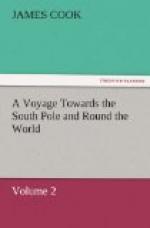But whether these lands be separate isles, or connected with New Caledonia, it is by no means certain that we saw their termination to the west. I think we did not; as the shoals did not end with the land we saw, but kept their N.W. direction farther than Bougainville’s track in the latitude of 15 deg. or 15 deg. 1/2. Nay, it seems not improbable, that a chain of isles, sand-banks, and reefs, may extend to the west, as far as the coast of New South Wales. The eastern extent of the isles and shoals off that coast, between the latitude of 15 deg. and 23’, were not known. The resemblance of the two countries; Bougainville’s meeting with the shoal of Diana above sixty leagues from the coast; and the signs he had of land to the S.E.; all tend to increase the probability. I must confess that it is carrying probability and conjecture a little too far, to say what may lie in a space of two hundred leagues; but it is in some measure necessary, were it only to put some future navigator on his guard.
[See his Voyage, English translation p.303.]
Mr Wales determined the longitude of that part of New Caledonia we explored, by ninety-six sets of observations, which were reduced to one another by our trusty guide the watch. I found the variation of the compass to be 10 deg. 24’ E. This is the mean variation given by the three azimuth compasses we had on board, which would differ from each other a degree and a half, and sometimes more. I did not observe any difference in the variation between the N.W. and S.E. parts of this land, except when we were at anchor before Balade, where it was less than 10 deg.; but this I did not regard, as I found such an uniformity out at sea; and it is there where navigators want to know the variation. While we were on the N.E. coast, I thought the currents set to S.E. and W. or N.W. on the other side; but they are by no means considerable, and may, as probably, be channels of tides, as regular currents. In the narrow channels which divide the shoals, and those which communicate with the sea, the tides run strong; but their rise and fall are inconsiderable, not exceeding three feet and a half. The time of high-water, at the full and change, at Balade, is about six o’clock; but at Botany Isle we judged it would happen about ten or eleven o’clock.
CHAPTER XI.
Sequel of the Passage from New Caledonia to New Zealand, with an Account of the Discovery of Norfolk Island; and the Incidents that happened while the Ship lay in Queen Charlotte’s Sound.
1774 October




